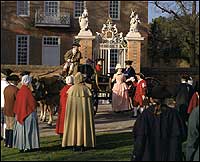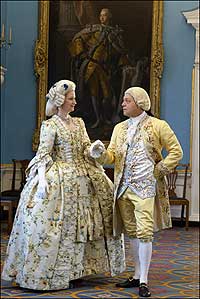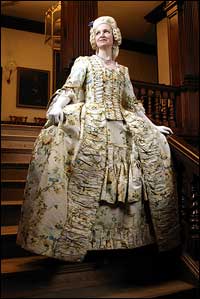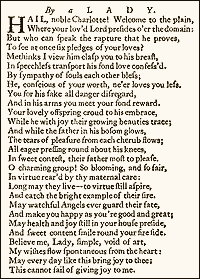Page content
The Governour's Lady
Mistresses of the Palace
by Mary Miley Theobald

Lord Dunmore welcomes his wife to the Governor's Palace in 1774. Interpreters Carson Hudson and Darci Tucker portray the first couple. - Photo by Dave Doody
She was the daughter of one earl and the wife of another; she marched in George III's coronation procession; she paid morning visits to the queen. And she left her life of luxury in the dead of winter 1773 to brave the treacherous Atlantic with her children and join her husband in Williamsburg.
Lady Charlotte Murray, wife of Virginia's governor, John Murray, the fourth Earl of Dunmore, had planned to winter in Naples. But Lord Dunmore wanted his family with him, and, as he could not visit them in England without resigning, they must come to him. He sent his personal secretary to deliver the message and accompany them on the voyage.
The ship reached New York the second day of 1774. Lady Charlotte brought six of her seven living children, and as many as ten servants. Her second son had died a few months earlier, and she had left her three-year-old with her sister, probably because he was too young or sickly to risk the trip. It was a rough, forty-four day crossing. They remained a month in New York—delayed by weather or the need to recuperate—and started south. Traveling by carriage and the Dunmore yacht, they stopped in Philadelphia, Baltimore, and Annapolis before reaching Williamsburg twenty-four days later.
The queen herself could not have had a more enthusiastic welcome. Cannon saluted their landing at Yorktown. Newspapers that had kept the capital informed of the family's progress published three effusive poems written in Lady Dunmore's honor. Williamsburg illuminated its houses with candles in the windows and celebrated with fireworks. The College of William and Mary and the city government sent delegates to congratulate the governor on the safe arrival of his loved ones. Crowds met them as they rode into town. "A great number of the most respectable citizens, and many from the country, who had been informed of her arrival, attended the carriages, in order to see her ladyship safe at the Palace, and then returned to their respective homes," reported the Virginia Gazette.
How long she planned to stay is a question. Dunmore had purchased large estates a few miles from Williamsburg and near Warm Springs—now Berkeley Springs, West Virginia—but neither had a habitable home. They would live at the Palace, a smaller residence than they were used to but, with its third floor bedchambers, large enough.
Lady Dunmore was the highest-ranking woman in British North America. And she would be the last in the line of English first ladies to make of the Palace her home.
Because of Charlotte Murray's position, historians know more about her than they do of the other, nonaristocratic governors' wives. They all led private lives. Their arrivals and their departures were sometimes noted in the newspapers, but little else was deemed appropriate for public consumption.
Most of the men who governed eighteenth-century Virginia were lieutenant governors—the titular governor appointed by the crown often elected not to hazard the sea crossing to a distant colony where disease and danger headed the greeting committee. Dunmore and his predecessor, Norborne Berkeley, Baron de Botetourt, were the only full governors who came to Virginia in the eighteenth century. Lieutenant governors were usually drawn from the military or the foreign service. They and their wives were gentry, not aristocracy, which means less information about them for historians.
Almost nothing is known about the first governor's wife to live in Williamsburg's Palace. Hester Drysdale accompanied her husband, Hugh, to Williamsburg in 1722 when he began his term. He was about fifty-two; she, probably younger. They seem to have had one child, a daughter Ann, age unknown.
Drysdale died in office after four years. He was popular, and the Governor's Council hastened to tell his widow that "they desire she will please to continue in the Governor's house, and make use of any other Conveniences about it during her stay here."
Hester Drysdale's first name would probably be lost to history had her husband not referred to her, once, in his short will. Drysdale made her sole executrix of his estate and left everything to her.
What did she do in Williamsburg, day in and day out? A reasonable guess would have her acting much as the mistress of a large plantation, directing household servants and slaves, supervising food preparation and meals, presiding over social functions, placing orders from England, doing needlework, and writing to friends and relatives. When her husband died, she stayed at the Palace long enough to make her plans, then probably went to live out the rest of her life in England.
Drysdale's successor, William Gooch, governed for more than twenty years. Esteemed by the colonists, Gooch, like Drysdale, had been a soldier. He, too, was married and had one child.

Under the kingly gaze of George III in the Palace ballroom, Lord and Lady Dunmore, portrayed by Jane Hanson and Phil Shultz, pose in embroidered finery. - Photo by Dave Doody
His wife was Rebecca Staunton—Gooch named the town of Staunton, Virginia, for her—and she was the daughter of a squire from Middlesex, England. She had her eleven-year-old son William and her unmarried sister Anne with her when she arrived. How long Anne stayed is not known. Young William grew up at the Palace, became the naval officer of the York River District, married, and died at twenty-six of the "bloody flux." His parents were left, brokenhearted, with a daughter-in-law, Nelly, not yet nineteen and seven months pregnant. The baby did not survive.
Late in his term, Gooch was created a baronet, elevating Rebecca to Lady Rebecca. It was the most exalted title in the colony. Many times she presided with her husband over the annual celebration of the king's birthday, a "handsome Entertainment for the Gentlemen and ladies, together with a Ball."
Five years after his son's death, Gooch resigned. He and Lady Rebecca sailed home. Their income was modest, and their new house suffered in comparison with the Palace. "Ye great parlor is almost as broad as our dressing room at Williamsburg and within 2 foot as long," she wrote, and "ye other about ye size of my closet, we have four chambers on ye first floor and two light closets and as many garrots and I believe they'd all stand in ye hall."
Lady Rebecca outlived her husband by a quarter century, dying at eighty-five in Bath, where the elderly and infirm had been going to "take the waters" since Roman times. She had no children to care for her in old age; perhaps she lived with relatives. The Gazette published a note when she died in 1775, leaving us with our only personal detail—her excellent eyesight. "It is but a few months," it said, "since this venerable Lady could see to thread the finest cambrick needle, without spectacles."
She left a four-volume Bible and a covered silver-gilt cup to the College of William and Mary chapel, evidence of the affection she felt for the town that had welcomed her fifty years earlier. The Bible was destroyed in an 1859 library fire, but the cup survives.
"This day abt noon we had ye news of Govr Dinwiddie's safe arrival at York wth his lady and 2 daughters," wrote John Blair, president of the council. Blair invited Robert Dinwiddie and family to dinner at his home and noted in his diary that "many ladies and gentn visited them in the afternoon, and were highly pleased with them." Another council member, the Rev. Thomas Dawson, found the Dinwiddies "courteous and affable . . . easy and agreeable to all their acquaintances." Rebecca Dinwiddie lived in Virginia seven years, making friends with whom she corresponded the rest of her life.
It was November 20, 1751, when the Dinwiddie family arrived. The Palace was under repair. Arrangements were made for their temporary residence at the house next door, today the Robert Carter House. It would be a year before they could relocate to the Palace, and no sooner had they settled in than construction of the ballroom wing began.
Dinwiddie came from a line of Scottish merchants, but moved into colonial administration as a young man. His first assignment took him to Bermuda, where he met his wife to be. She was the only child of Andrew Auchinleck, the colony's principal Anglican minister and once, briefly, acting governor. Dinwiddie was much older than she. They were married in Bermuda, and in 1738 their first daughter, Elizabeth, was born. The younger child, Rebecca, arrived three years later.
Life in Williamsburg with two young ladies—the girls were ten and thirteen when they came—must have been a busy round of household management, lessons, and social activities. During their first summer, the governor granted Lewis Hallam, a celebrated actor and theater manager, permission to alter the old "Play-House at Williamsburg to a regular Theatre, fit for the Reception of Ladies and Gentlemen." Surely the Dinwiddies attended Hallam productions. Their move into the Palace in November of 1752 coincided with the king's birthday. The governor hired Hallam to "exhibit several fireworks in Palace Street," and the city was illuminated. Rebecca Dinwiddie presided over a Palace ball attended that year by "the Emperor of the Cherokee Nation with his Empress and their Son the young Prince."
Dinwiddie resigned in 1758 and returned to England with his wife and daughters, then seventeen and twenty. They, too, found Bath agreeable, for they made many trips there for the warm pools and the social life. In 1770, Robert died, leaving his widow and daughters comfortably established. She must have been pleased to see her younger daughter married the next year to a gentleman from the Isle of Man, but there were no grandchildren from that union to liven her later years. Her daughter Elizabeth died at thirty-five, unmarried. Rebecca Dinwiddie died in London in 1793, 101 years after her husband's birth.
Catherine Dalston, daughter of Sir Charles Dalston, had been married to Francis Fauquier for about twenty-eight years when he was appointed governor. As a young man, he was already a polished gentleman: well educated, an amateur scientist, an accomplished musician, and wealthy since inheriting a modest fortune at the age of twenty-three. But he was also a hard drinker who indulged—too much, some said—in gambling and racing.
There were no children at the Palace during Fauquier's government—sons Francis and William were adults—but Catherine Fauquier's life was probably full of social events. Her husband enjoyed the company of intelligent, accomplished people. There were many dinners and concerts, and she undoubtedly came to know young Thomas Jefferson, George Wythe, William Small, and others from the college. She became close to the Robert Carter family, and was godmother to their fourth daughter.
But after eight years she went home. "On Saturday last," reported the Gazette, "our Governour's Lady, and his son, Francis Fauquier, Esq, went on board the Randolph, Capt. Walker, at Burwell's ferry, to take their passage for London." She did not see her husband again. He died in office, at sixty-four, and is buried at Bruton Parish Church. She lived to see both sons marry and her only grandchild, William, born in 1776. Catherine Fauquier died in her home in London's fashionable Cavendish Square in 1781.
Fauquier was succeeded by Botetourt, a bachelor, and the first full governor to come to Virginia in the eighteenth century. Like Fauquier, he died in office and was buried in Williamsburg. His successor, John Murray, Earl of Dunmore, was Virginia's last colonial chief executive.
Dunmore was a captain in the Scots Guard when Lady Charlotte Stewart married him in 1759. They were first cousins once removed. She was probably eighteen or nineteen; he was nearly thirty. Both were Scots, wealthy and well born—he an earl and a dashing officer, educated and personable; she the beautiful daughter of one of Scotland's leading families, socially connected in ways that would help his career. Hers was the better family, but her marriage made her a countess.

Hooped and bewigged, Jane Hanson as Lady Dunmore. - Photo by Dave Doody

The Virginia Gazette
welcomed her ladyship. - Photo by Dave Doody
Lady Charlotte's siblings were as well connected as she, and she never scrupled to use them to further her husband's career. After an active decade in London, where Dunmore took one of the seats reserved for Scots in the House of Lords, he was rewarded with the governorship of New York. Charlotte did not come with him; she was pregnant with their eighth child, and the trip was too hazardous.
Weeks after Dunmore arrived in New York, Virginia's Lord Botetourt died. Charlotte worked quickly to help secure the vacant post for her husband. Virginia's governor was the highest paid, and the position had the best perks. Like many nobles, the Dunmores were heavy spenders and usually strapped for cash. Before others could lobby for the vacancy, Charlotte, whose brother-in-law sat on the Privy Council, had the appointment in hand. And never mind that her husband liked New York and didn't want to move south to such a disagreeable climate. He left New York in 1771 after less than a year.
In about a dozen years, Charlotte Murray produced eight children and gave birth to her ninth. She was among the most beautiful women of her day. Contemporaries spoke of her as quiet and charming; a prominent New Yorker described her as "very elegant." "She looks, speaks and moves and is a lady," he wrote. A Virginian said, "At first sight, it seemed to me that she deserved a better husband and I soon learned that I was not mistaken. There were two daughters—one seventeen and the other fifteen and a half years old—as charming as their mother, both in personality and in appearance." She danced beautifully, so well that one observer wrote it seemed "that we had never seen dancing before."
She settled her family into the Palace that winter and immediately became pregnant. The two younger boys were enrolled in the Grammar School at William and Mary, the older instructed by the master of the college. The girls probably had lessons at home in subjects that would enhance their marriageability, such as dancing, music, and drawing.
There were no women of her rank with whom Charlotte Murray might socialize. Her husband was absent for months, leading military expeditions into the Ohio valley to fight the Shawnee. But the Palace was full of children and musical instruments—a pianoforte, a harpsichord, three chamber organs, and others—surely a formula for lessons, practice, singing, and dancing.
Dunmore returned from the frontier the day after the birth of their ninth child, christened Virginia. The Gazette reported: "Countess of Dunmore was safely delivered of a Daughter at the palace. Her Ladyship continues in a very favourable Situation, and the young Virginian is in perfect Health." Charlotte Murray was the only royal governor's wife to give birth at the Palace. A grand ball six weeks later celebrated the baby's christening, the birthday of the queen, and Dunmore's treaty with the Shawnee. The governor was at the height of his popularity. By spring, his relations with the colonists had soured.
In April 1775, amid growing political unrest, the countess and her children were hustled off in the middle of the night for their safety to a British man-of-war. The townspeople were affronted. She was in no danger from them. She was widely respected and even adored by many in Williamsburg. She returned to the Palace for a quiet May, but revolution neared. In June, she left, taking her children, nurse, chaplain, and servants with her. She was pregnant with her tenth child.
Dunmore became governor of the Bahamas in 1785. "Charlotte was always very involved in his career," says Pete Wrike, a historian and Colonial Williamsburg character interpreter who is writing a biography of Dunmore, but there is no evidence that she visited him in the Bahamas.
In 1793 Charlotte Murray went on a grand tour of Europe with her sister and daughters. In Italy, her second daughter met Prince Augustus, the fourth son of King George III. They fell in love and entered into a questionable and unsanctioned marriage. The scandal, Wrike says, led to royal displeasure that contributed to Dunmore's recall. His government career was over, but at sixty-six, perhaps he was ready to retire to his wife and family, his estates, and his businesses back home.
Lady Charlotte outlived him by nine years, dying in 1818 at Southwood House, their estate near the southeastern tip of England. She was Virginia's first and last countess.
Suggestions for further reading:
